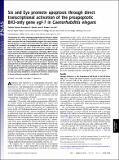Six and Eya promote apoptosis through direct transcriptional activation of the proapoptotic BH3-only gene egl-1 in Caenorhabditis elegans
Author(s)
Hirose, Takashi; Galvin, Brendan D.; Horvitz, Howard Robert
DownloadHorvitz_Six and eya.pdf (2.202Mb)
PUBLISHER_POLICY
Publisher Policy
Article is made available in accordance with the publisher's policy and may be subject to US copyright law. Please refer to the publisher's site for terms of use.
Terms of use
Metadata
Show full item recordAbstract
The decision of a cell to undergo programmed cell death is tightly regulated during animal development and tissue homeostasis. Here, we show that the Caenorhabditis elegans Six family homeodomain protein C. elegans homeobox (CEH-34) and the Eyes absent ortholog EYA-1 promote the programmed cell death of a specific pharyngeal neuron, the sister of the M4 motor neuron. Loss of either ceh-34 or eya-1 function causes survival of the M4 sister cell, which normally undergoes programmed cell death. CEH-34 physically interacts with the conserved EYA domain of EYA-1 in vitro. We identify an egl-1 5′ cis-regulatory element that controls the programmed cell death of the M4 sister cell and show that CEH-34 binds directly to this site. Expression of the proapoptotic gene egl-1 in the M4 sister cell requires ceh-34 and eya-1 function. We conclude that an evolutionarily conserved complex that includes CEH-34 and EYA-1 directly activates egl-1 expression through a 5′ cis-regulatory element to promote the programmed cell death of the M4 sister cell. We suggest that the regulation of apoptosis by Six and Eya family members is conserved in mammals and involved in human diseases caused by mutations in Six and Eya.
Date issued
2010-08Department
Massachusetts Institute of Technology. Department of BiologyJournal
Proceedings of the National Academy of Sciences
Publisher
National Academy of Sciences (U.S.)
Citation
Hirose, T., B. D. Galvin, and H. R. Horvitz. “Six and Eya promote apoptosis through direct transcriptional activation of the proapoptotic BH3-only gene egl-1 in Caenorhabditis elegans.” Proceedings of the National Academy of Sciences 107, no. 35 (August 31, 2010): 15479-15484.
Version: Final published version
ISSN
0027-8424
1091-6490